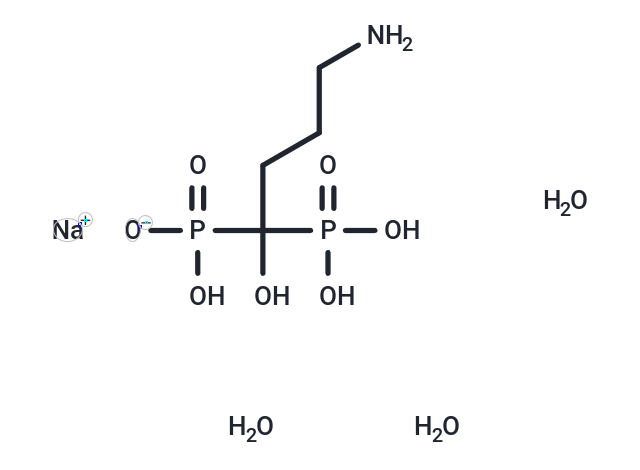Shopping Cart
- Remove All
 Your shopping cart is currently empty
Your shopping cart is currently empty

Alendronate sodium hydrate (MK 217) is a nitrogen-containing bisphosphonate, which is an effective inhibitor of bone resorption. It is utilized for the treatment and prevention of osteoporosis.

| Pack Size | Price | Availability | Quantity |
|---|---|---|---|
| 50 mg | $40 | In Stock | |
| 100 mg | $48 | In Stock | |
| 200 mg | $54 | In Stock | |
| 500 mg | $85 | In Stock |
| Description | Alendronate sodium hydrate (MK 217) is a nitrogen-containing bisphosphonate, which is an effective inhibitor of bone resorption. It is utilized for the treatment and prevention of osteoporosis. |
| Targets&IC50 | FPPS:460 nM. |
| In vitro | In mice, pretreatment with 0.1 mg/kg of Alendronate one to two times a week, in combination with 10-50 mg/kg of paclitaxel, effectively inhibits the growth of PC-3 ML tumors in bone marrow and soft tissue, significantly extending survival times to 4-5 weeks. In rats, Alendronate exacerbates indomethacin-induced gastric damage and delays the healing of gastric ulcers. In rabbits, Alendronate causes gastric erosion and increases the incidence and area of indomethacin-induced antral ulcers. |
| In vivo | Sodium alendronate primarily inhibits the rate-limiting step in the cholesterol biosynthesis pathway within osteoclasts. Lowering the levels of farnesyl pyrophosphate interferes with protein prenylation and concurrently inhibits the biosynthesis pathway of isoprenoids. Additionally, sodium alendronate acts to suppress sterol in osteoclasts. |
| Kinase Assay | Rat liver cytosol is prepared from a separate piece of liver from rat. Assays are carried out in a total volume of 0.1 mL containing 10 mg of cytosolic protein, and components according to Rilling. All reaction components (except IPP) are mixed and kept on ice for 15 min. Reactions are initiated by the addition of [14C]IPP and incubation at 37°C. Reactions are stopped after 5 min by addition of 0.4 mL MeOH/HCl (4/1, by vol.) and the samples are incubated a further 15 min to hydrolyze the allylic pyrophosphates to petroleum ether-extractable products. Following addition of 0.5 mL water and 1 mL petroleum ether, 50% of the upper (petroleum ether-extractable) phase is taken for liquid scintillation analysis. Preliminary experiments indicated that the reaction is linear with time and protein under these conditions, and no more than 10% of the substrate is consumed. |
| Alias | G-704650 Adronat |
| Molecular Weight | 325.12 |
| Formula | C4H12NO7P2·3H2O·Na |
| Cas No. | 121268-17-5 |
| Smiles | C(CC(O)(P(=O)(O)O)P(=O)(O)[O-])CN.O.[Na+].O.O |
| Relative Density. | 1.857g/cm3 |
| Storage | Powder: -20°C for 3 years | In solvent: -80°C for 1 year | Shipping with blue ice. | ||||||||||||||||||||||||||||||
| Solubility Information | H2O: 28.57 mg/mL (87.88 mM), Sonication is recommended. DMSO: Slightly soluble | ||||||||||||||||||||||||||||||
Solution Preparation Table | |||||||||||||||||||||||||||||||
H2O
| |||||||||||||||||||||||||||||||

Copyright © 2015-2024 TargetMol Chemicals Inc. All Rights Reserved.